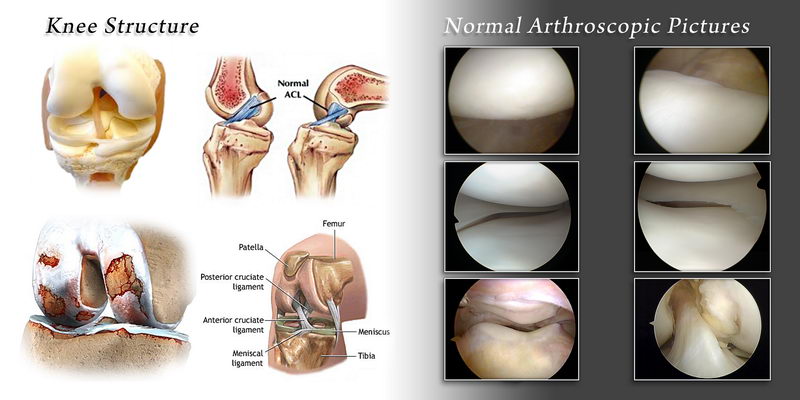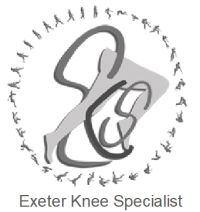Normal Structure of the Knee, including keyhole surgery examples
The knee joint is made up of three bones: the femur (thigh bone), the tibia (shin bone), and the patella (knee cap). The joint surfaces of these bones are covered with a smooth layer called articular cartilage, which glides over each other without causing any friction.

Common Problems
Knee pain is a common complaint among adults and most often associated with general wear and tear from daily activities, sport or fitness programmes. Athletes who run or play sports that involve jumping or quick pivoting are also more likely to experience knee pain and problems. Whether an individual’s knee pain is caused by aging or injury, it can sometimes severely affect daily living activities and be very debilitating.
Pain
In diagnosing knee pain it is important to identify its location as this frequently indicates which type of tissue is likely to be involved.
Anterior knee pain (at the front)
Medial knee pain (on the inner side)
Lateral knee pain ( on the outer side)
Posterior knee pain (at the back)
Next the nature of the pain because this also helps to identify the possible cause.
Constant pain around the whole knee
Sudden sharp pain usually in a specific part of the knee joint
A change in sensation, burning, prickling or tingling
Referred pain, something else is the cause
Constant pain involving the whole knee joint is usually due to inflammation caused by infection or joint damage. Osteoarthritis, when the knee has started to wear down, is a good example of this. Osteoarthritic pain often occurs at rest and at night. It can improve initially on exercise becoming painful again after longer periods walking or on more strenuous exercise.
Sudden sharp pain is a common symptom of a mechanical problem such as a tear in a ligament, tendon or cartilage. This type of pain is common in sports injuries when a specific incident has occurred.
Burning pain is usually inflammatory in origin and can also be seen in nerve problems affecting the leg. In the complex structure surrounding the knee nerves can get trapped or become damaged perhaps as a result of other conditions.
Referred pain can happen when there is injury or damage to another part of your body. In particular there are nerves in your lower back that are linked to the muscles surrounding the knee joint. If any of these nerves become damaged, referred pain in the knee may be experienced. Sciatica is a good example of this. The sciatic nerve runs down your leg from the pelvis to the foot and will cause referred pain if it becomes damaged or trapped. Nerve damage can be due to a number of reasons including arthritis, trauma and prolapsed discs.

